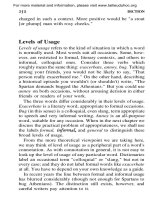Writing band descriptors
Bạn đang xem bản rút gọn của tài liệu. Xem và tải ngay bản đầy đủ của tài liệu tại đây (37 KB, 2 trang )
Page 1 of 2
IELTS Task 2 Writing band descriptors (public version)
Band Task Response Coherence and Cohesion Lexical Resource Grammatical Range and Accuracy
9
fully addresses all parts of the task
presents a fully developed position in
answer to the question with relevant, fully
extended and well supported ideas
uses cohesion in such a way that it
attracts no attention
skilfully manages paragraphing
uses a wide range of vocabulary
with very natural and
sophisticated control of lexical
features; rare minor errors occur
only as ‘slips’
uses a wide range of structures with
full flexibility and accuracy; rare minor
errors occur only as ‘slips’
8
sufficiently addresses all parts of the task
presents a well-developed response to the
question with relevant, extended and
supported ideas
sequences information and ideas
logically
manages all aspects of cohesion well
uses paragraphing sufficiently and
appropriately
uses a wide range of vocabulary
fluently and flexibly to convey
precise meanings
skilfully uses uncommon lexical
items but there may be
occasional inaccuracies in word
choice and collocation
produces rare errors in spelling
and/or word formation
uses a wide range of structures
the majority of sentences are error-free
makes only very occasional errors or
inappropriacies
7
addresses all parts of the task
presents a clear position throughout the
response
presents, extends and supports main ideas,
but there may be a tendency to over-
generalise and/or supporting ideas may
lack focus
logically organises information and ideas;
there is clear progression throughout
uses a range of cohesive devices
appropriately although there may be
some under-/over-use
presents a clear central topic within each
paragraph
uses a sufficient range of
vocabulary to allow some
flexibility and precision
uses less common lexical items
with some awareness of style
and collocation
may produce occasional errors
in word choice, spelling and/or
word formation
uses a variety of complex structures
produces frequent error-free sentences
has good control of grammar and
punctuation but may make a few errors
6
addresses all parts of the task although
some parts may be more fully covered than
others
presents a relevant position although the
conclusions may become unclear or
repetitive
presents relevant main ideas but some may
be inadequately developed/unclear
arranges information and ideas
coherently and there is a clear overall
progression
uses cohesive devices effectively, but
cohesion within and/or between
sentences may be faulty or mechanical
may not always use referencing clearly or
appropriately
uses paragraphing, but not always
logically
uses an adequate range of
vocabulary for the task
attempts to use less common
vocabulary but with some
inaccuracy
makes some errors in spelling
and/or word formation, but they
do not impede communication
uses a mix of simple and complex
sentence forms
makes some errors in grammar and
punctuation but they rarely reduce
communication
5
addresses the task only partially; the format
may be inappropriate in places
expresses a position but the development
is not always clear and there may be no
presents information with some
organisation but there may be a lack of
overall progression
makes inadequate, inaccurate or over-
uses a limited range of
vocabulary, but this is minimally
adequate for the task
may make noticeable errors in
uses only a limited range of structures
attempts complex sentences but these
tend to be less accurate than simple
sentences
Page 2 of 2
conclusions drawn
presents some main ideas but these are
limited and not sufficiently developed; there
may be irrelevant detail
use of cohesive devices
may be repetitive because of lack of
referencing and substitution
may not write in paragraphs, or
paragraphing may be inadequate
spelling and/or word formation
that may cause some difficulty
for the reader
may make frequent grammatical errors
and punctuation may be faulty; errors
can cause some difficulty for the
reader
4
responds to the task only in a minimal way
or the answer is tangential; the format may
be inappropriate
presents a position but this is unclear
presents some main ideas but these are
difficult to identify and may be repetitive,
irrelevant or not well supported
presents information and ideas but these
are not arranged coherently and there is
no clear progression in the response
uses some basic cohesive devices but
these may be inaccurate or repetitive
may not write in paragraphs or their use
may be confusing
uses only basic vocabulary
which may be used repetitively
or which may be inappropriate
for the task
has limited control of word
formation and/or spelling; errors
may cause strain for the reader
uses only a very limited range of
structures with only rare use of
subordinate clauses
some structures are accurate but
errors predominate, and punctuation is
often faulty
3
does not adequately address any part of
the task
does not express a clear position
presents few ideas, which are largely
undeveloped or irrelevant
does not organise ideas logically
may use a very limited range of cohesive
devices, and those used may not indicate
a logical relationship between ideas
uses only a very limited range of
words and expressions with
very limited control of word
formation and/or spelling
errors may severely distort the
message
attempts sentence forms but errors in
grammar and punctuation predominate
and distort the meaning
2
barely responds to the task
does not express a position
may attempt to present one or two ideas
but there is no development
has very little control of organisational
features
uses an extremely limited range
of vocabulary; essentially no
control of word formation and/or
spelling
cannot use sentence forms except in
memorised phrases
1
answer is completely unrelated to the task
fails to communicate any message
can only use a few isolated
words
cannot use sentence forms at all
0
does not attend
does not attempt the task in any way
writes a totally memorised response









